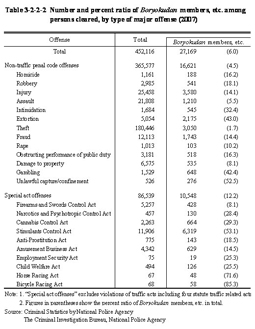| Previous Next Index Image Index Year Selection | |
|
|
1 Penal code offenses and special act offenses Those members cleared were stable between 30,000 and 40,000 since 1989, but were below 30,000 since 2004, and were 27,169 in 2007 (a decrease of 4.4% from the previous year). Fig. 3-2-2-1 Number of Boryokudan members,etc. cleared for non-traffic penal code offenses and special act offenses (1978–2007) Table 3-2-2-2 shows occupancy of the number and percent ratio of Boryokudan members, etc. in the total persons cleared for non-traffic penal code offenses and special act offenses, by major offense in 2007.Table 3-2-2-2 Number and percent ratio of Boryokudan members, etc. among persons cleared, by type of major offense (2007) Boryokudan members, etc. occupied a large portion of the total number of persons cleared for unlawful capture/confinement, extortion, gambling, and intimidation for non-traffic penal code offenses, and Bicycle Racing Act violations, Horse Racing Act violations, Stimulants Control Act violations, Cannabis Control Act violations, and Narcotics and Psychotropic Control Act violations for special act offenses.Looking at the number of Boryokudan members, etc. cleared by type of offense, Stimulants Control Act violations were the highest, followed by injury, theft, and extortion in such order. |

